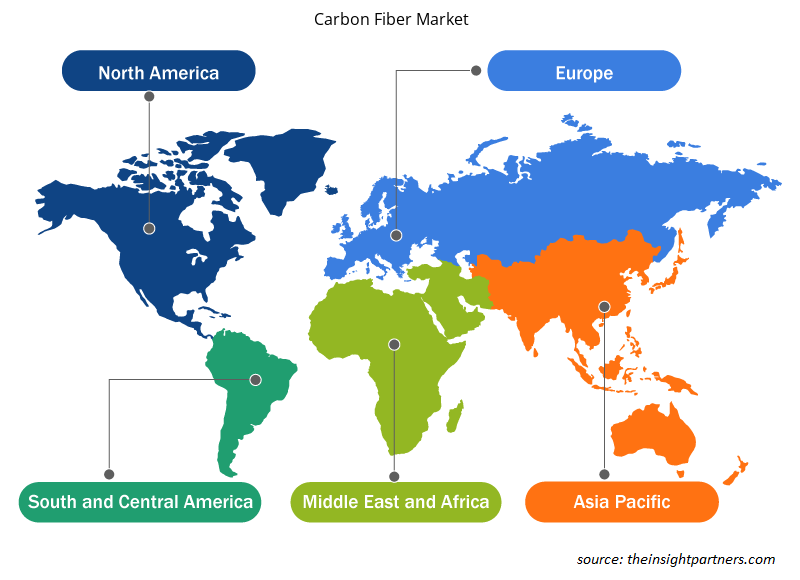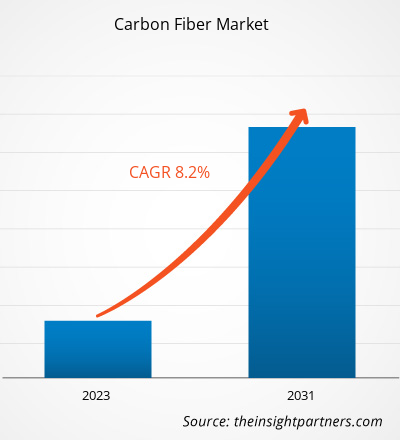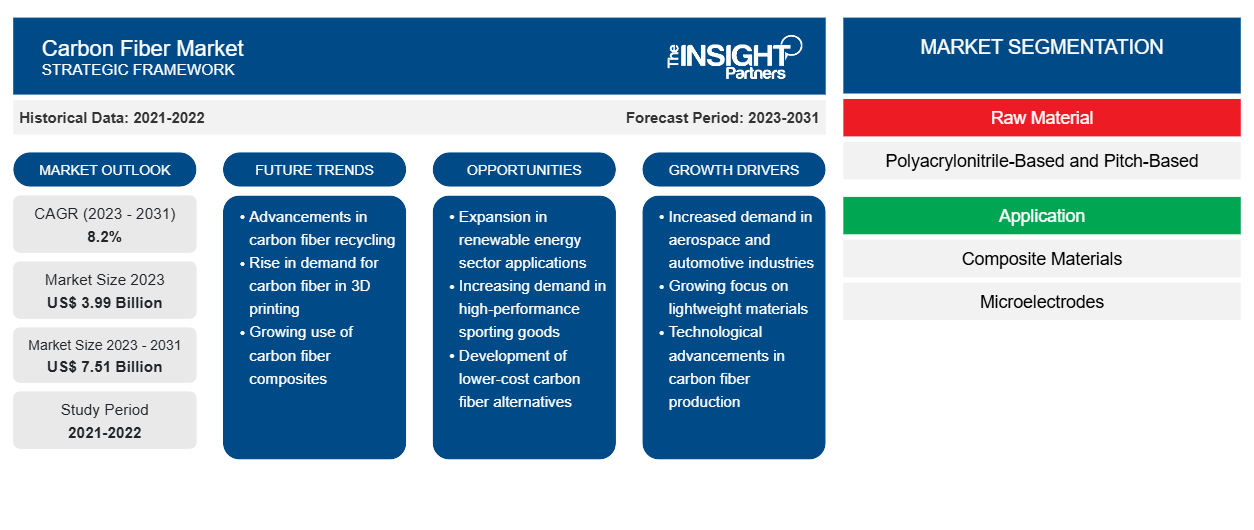탄소섬유 시장 규모는 2023년 39억 9,000만 달러에서 2031년 75억 1,000만 달러로 성장할 것으로 예상됩니다. 이 시장은 2023~2031년 동안 8.2%의 CAGR을 기록할 것으로 예상됩니다. 항공우주, 자동차, 스포츠 장비, 산업 분야의 수요 증가는 미래에 새로운 탄소섬유 시장 트렌드를 가져올 가능성이 높습니다.
탄소섬유 시장 분석
탄소 섬유는 놀라운 기계적 강도, 강성, 내열성 및 내화학성을 가지고 있습니다. 탄소 섬유는 강철이나 알루미늄보다 상당히 가볍지만 상대적으로 또는 더 우수한 강도를 보입니다. 이로 인해 탄소 섬유는 항공우주, 자동차, 스포츠 장비 및 산업 분야와 같이 중량 감소가 중요한 응용 분야에서 수요가 많은 소재가 되었습니다. 탄소 섬유 시장은 다양한 분야의 산업이 가볍고 내구성이 뛰어나며 에너지 효율적인 소재에 대한 요구를 충족하기 위해 탄소 섬유 복합재를 점점 더 많이 채택함에 따라 계속 성장할 것으로 예상됩니다. 탄소 섬유 제조 공정의 기술적 발전과 비용 효율적인 생산 기술의 개발도 향후 몇 년 동안 시장 확대에 기여할 가능성이 높습니다.
탄소섬유 시장 개요
자동차 제조업체는 높은 기계적 및 인장 강도를 가진 경량 자동차 구성품을 생산하기 위해 혁신적이고 고품질의 소재를 찾습니다. 탄소 섬유는 경량 자동차 부품 생산에 가장 적합한 소재 중 하나로 간주됩니다. 게다가 탄소 섬유 강화 복합재는 무게가 더 무겁고 연료 효율이 떨어지는 강철 및 알루미늄 부품을 대체하는 필수 소재로 사용됩니다. 자동차 산업에서 탄소 섬유를 사용하면 연료 효율이 향상되어 에너지 절약이 이루어지고 이산화탄소 배출이 최소화됩니다. 주요 자동차 제조업체는 구성품을 제조하는 데 탄소 섬유를 사용하고 있습니다. 예를 들어, Airbus A350 유닛은 52%의 탄소 섬유 강화 폴리머(CFRP)로 구성되어 있는 반면 BMW i3 유닛은 대부분 CFRP 섀시를 사용합니다.
귀하의 요구 사항에 맞게 이 보고서를 사용자 정의하세요
이 보고서의 일부 또는 국가 수준 분석, Excel 데이터 팩을 포함하여 모든 보고서에 대한 사용자 정의를 무료로 받을 수 있으며 신생 기업 및 대학을 위한 훌륭한 혜택과 할인 혜택을 이용할 수 있습니다.
-
이 보고서의 주요 시장 동향을 알아보세요.이 무료 샘플에는 시장 동향부터 추정 및 예측까지 다양한 데이터 분석이 포함됩니다.
탄소섬유 시장 지역 통찰력
Insight Partners의 분석가들은 예측 기간 동안 탄소 섬유 시장에 영향을 미치는 지역적 추세와 요인을 철저히 설명했습니다. 이 섹션에서는 북미, 유럽, 아시아 태평양, 중동 및 아프리카, 남미 및 중미의 탄소 섬유 시장 세그먼트와 지리에 대해서도 설명합니다.

- 탄소섬유 시장에 대한 지역별 특정 데이터 얻기
탄소섬유 시장 보고서 범위
| 보고서 속성 | 세부 |
|---|---|
| 2023년 시장 규모 | 39억 9천만 달러 |
| 2031년까지 시장 규모 | 75억 1천만 달러 |
| 글로벌 CAGR (2023-2031)CAGR (2023 - 2031) | 8.2% |
| 역사적 데이터 | 2021-2022 |
| 예측 기간 | 2023-2031 |
| 다루는 세그먼트 |
원자재별
|
| 포함된 지역 및 국가 |
북아메리카
|
| 시장 선도 기업 및 주요 회사 프로필 |
|
시장 참여자 밀도: 비즈니스 역학에 미치는 영향 이해
탄소 섬유 시장은 소비자 선호도의 변화, 기술 발전, 제품의 이점에 대한 인식 증가와 같은 요인으로 인해 최종 사용자 수요가 증가함에 따라 빠르게 성장하고 있습니다. 수요가 증가함에 따라 기업은 제품을 확장하고, 소비자의 요구를 충족하기 위해 혁신하고, 새로운 트렌드를 활용하여 시장 성장을 더욱 촉진하고 있습니다.
시장 참여자 밀도는 특정 시장이나 산업 내에서 운영되는 회사나 기업의 분포를 말합니다. 주어진 시장 공간에 얼마나 많은 경쟁자(시장 참여자)가 존재하는지 그 규모나 전체 시장 가치에 비해 나타냅니다.
탄소섬유 시장에서 활동하는 주요 기업은 다음과 같습니다.
- SGL 카본 SE
- DowAksa Advanced Composite Material Industries Ltd Co
- 포모사 플라스틱스 코퍼레이션
- 헥셀 주식회사
- 효성첨단소재(주)
- 쿠레하 주식회사
면책 조항 : 위에 나열된 회사는 어떤 특별한 순서에 따라 순위가 매겨지지 않았습니다.

- 탄소섬유 시장 주요 기업 개요를 알아보세요
탄소섬유 시장 뉴스 및 최근 동향
탄소 섬유 시장은 1차 및 2차 조사 이후의 정성적, 정량적 데이터를 수집하여 평가합니다. 여기에는 중요한 기업 간행물, 협회 데이터 및 데이터베이스가 포함됩니다. 다음은 탄소 섬유 시장의 개발 목록입니다.
- Toray Industries, Inc.는 오늘 1,160킬로파운드/제곱인치(Ksi)의 세계에서 가장 높은 강도를 가진 TORAYCA T1200 탄소 섬유를 개발했다고 발표했습니다. 이 새로운 제품은 탄소 섬유 강화 플라스틱 소재를 가볍게 하여 환경적 발자국을 줄이는 데 앞장서게 될 것입니다. 이 섬유는 또한 강도 중심 응용 분야에 새로운 성능 경계를 열어줍니다. 잠재적 응용 분야는 항공 구조물과 방위에서 대체 에너지와 소비자 제품에 이르기까지 다양합니다. (출처: Toray Advanced Composites, 보도 자료, 2023)
- SGL Carbon은 JEC World 2023에서 새로운 50k 탄소 섬유를 선보일 예정입니다. 새로운 SIGRAFIL C T50-4.9/235 탄소 섬유는 일반적인 압력 용기 설계에 대한 고강도 요구 사항을 충족하며 높은 신장 용량을 보여줍니다. 또한 고강도와 신장이 필요한 시장 부문에서 추가 적용이 가능합니다. (출처: SGL Carbon, 보도 자료, 2023)
탄소섬유 시장 보고서 범위 및 제공물
"탄소 섬유 시장 규모 및 예측(2021-2031)" 보고서는 아래 영역을 포괄하는 시장에 대한 자세한 분석을 제공합니다.
- 범위에 포함된 모든 주요 시장 세그먼트에 대한 글로벌, 지역 및 국가 수준의 시장 규모 및 예측
- 동인, 제약 및 주요 기회와 같은 시장 역학
- 주요 미래 트렌드
- 포터의 5가지 힘과 SWOT 분석에 대한 자세한 설명
- 주요 시장 동향, 주요 업체, 규정 및 최근 시장 동향을 포괄하는 글로벌 및 지역 시장 분석
- 시장 집중도, 히트맵 분석, 유명 기업 및 최근 개발 사항을 포함하는 산업 환경 및 경쟁 분석
- 자세한 회사 프로필
- 과거 분석(2년), 기준 연도, CAGR을 포함한 예측(7년)
- PEST 및 SWOT 분석
- 시장 규모 가치/거래량 - 글로벌, 지역, 국가
- 산업 및 경쟁 환경
- Excel 데이터세트
최근 보고서
관련 보고서
사용 후기
구매 이유
- 정보에 기반한 의사 결정
- 시장 역학 이해
- 경쟁 분석
- 고객 인사이트
- 시장 예측
- 위험 완화
- 전략 기획
- 투자 타당성 분석
- 신흥 시장 파악
- 마케팅 전략 강화
- 운영 효율성 향상
- 규제 동향에 발맞춰 대응























 무료 샘플 받기 - 탄소섬유 시장
무료 샘플 받기 - 탄소섬유 시장